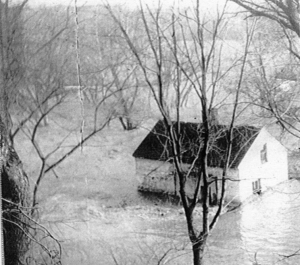Swains Lockhouse, soon to be the seventh Canal Quarters residence, sits in a picturesque location along the C&O Canal. The Potomac River, just yards away, provides wonderful views, radiant sunsets, cool breezes, and outdoor recreation.

The river can also pour across the floodplain buffer with devastating results.
Flooding has always been more than a threat along the C&O Canal. It has been a way of life. During the Canal era, major floods washed downstream from the 14,670 square mile Potomac watershed. Flood repair was expensive and interrupted the flow of commerce. Ultimately it was water damage after a flood in 1924 that closed the Canal for good.
In harm’s way.
Lock keepers needed to be constantly on guard for storms. In a narrow river bed with steep banks, much of the Canal had to be dug close to the river. Consequently, many of the lockhouses, including Swains, were built on floodplains.
Swains Lockhouse withstood major hits from all the big storms, including the 1852 flood that swelled the Potomac 64 feet at Great Falls just downstream. But it didn’t escape unscathed. In fact, Swains basement has been completely filled with silt from running floodwaters.
Raising the standards for flood protection.
When the Canal Trust, in partnership with the National Park Service (NPS), started planning the rehabilitation of Swains Lockhouse, the possibility of a future flood couldn’t be ignored. Rebecca Cybularz, historical architect for the NPS’ Historic Preservation Training Center, designed Swains rehab with many flood sensitive features built in.
“Swains Lockhouse has withstood some of the toughest weather and conditions Mother Nature could unleash,” said Rebecca. “It’s only fair that we help the historic building withstand these conditions for the next 100 years of its life.”
First floor construction at Swains consists of many flood resistant materials including:
- click-together vinyl flooring (it looks historic but can be removed when it floods!)
- closed-cell foam insulation at interior walls,
- removable wood wainscoting
- screened, cellular PVC crawlspace vent
- pressure-treated wood framing members and sheathing
Electrical outlets and switches on the first floor will all be located above the flood zone, which is up to three feet above the interior finished floor (Federal Emergency Management Agency standards). Mini split HVAC units will be hung on the wall near the ceiling—out of the flood zone.
Outside the lockhouse, special care will be taken to create positive drainage, which will divert water from the foundation as high water recedes.
If history is an indicator, big floods are few and far between on the Potomac, but they do occur. Next time the water rises, Swains Lockhouse will be ready!
Next Time
Why was Swains chosen and what does it have to do with the National Park service Centennial? Read it now!
